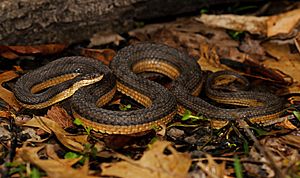Graham's crayfish snake facts for kids
Quick facts for kids Graham's crayfish snake |
|
|---|---|
 |
|
| Conservation status | |
| Scientific classification | |
| Genus: |
Regina
|
| Species: |
grahamii
|
| Synonyms | |
The Graham's crayfish snake (scientific name: Regina grahamii) is a type of snake that lives near water. It is not venomous, which means it is not poisonous. This snake is found only in the central United States. It belongs to the Colubridae family of snakes.
Contents
About the Graham's Crayfish Snake
What's in a Name?
The scientific name, grahamii, honors James Duncan Graham. He was a Lt. Col. in the U.S. Corps of Topographical Engineers. He was the one who first collected this snake.
Other Names for This Snake
Besides Graham's crayfish snake, people sometimes call it by other names. These include Arkansas water snake, Graham's leather snake, and prairie water snake. It's also known as Graham's queen snake or striped moccasin.
How to Identify a Graham's Crayfish Snake
The Graham's crayfish snake is a medium-sized snake. It usually measures about 18 to 28 inches (46–71 cm) long. Some can grow much larger, up to almost 4 feet (119 cm) in length.
These snakes are typically brown or gray. They might have a faint stripe down their back. Their sides have cream, white, tan, or light yellow stripes. These stripes go from their belly up to the fourth row of scales. The belly is usually light-colored and plain. Sometimes, there might be a row of dark dots in the middle of the belly, but this is rare.
No Subspecies
There are no different types or subspecies of the Graham's crayfish snake. It is just one recognized species.
Where Graham's Crayfish Snakes Live
Habitat and Home
Regina grahamii lives near muddy marshes, oxbow lakes, rivers, and streams. It especially likes ditches along roads that have many crayfish. These snakes often hide under rocks, logs, or other things near the water's edge. They also spend a lot of time inside crayfish burrows.
What Graham's Crayfish Snakes Eat
Diet and Food
The Graham's crayfish snake mainly eats crayfish. They especially like crayfish that have recently shed their hard outer shell. They have also been known to eat fish and amphibians.
Behavior and Defense
Temperament and How They Stay Safe
This snake's main ways of staying safe are by blending in (camouflage) and being active at night. If it feels scared, especially when it's warming itself in the sun, it will quickly escape into the water and hide. This snake is usually calm and gentle. However, if it gets caught, it might flatten its body and release a smelly liquid to scare off predators.
Life Cycle and Reproduction
How Graham's Crayfish Snakes Have Babies
Female Graham's crayfish snakes give birth to live young. They don't lay eggs. A mother snake can have a brood of 10 to 15 babies at a time. Each newborn snake is about 8 inches (20 cm) long.
Keeping Graham's Crayfish Snakes as Pets
In Captivity
It is very hard to keep Regina grahamii as a pet. They often refuse to eat when kept in captivity. They can also easily get skin problems. Only people who are very experienced with snakes should try to keep this species.
Where Graham's Crayfish Snakes Are Found
Geographic Range
The Graham's crayfish snake can be found in several states in the central United States. These include Arkansas, Illinois, Iowa, Kansas, Louisiana, Mississippi, Missouri, Nebraska, Oklahoma, and Texas.


